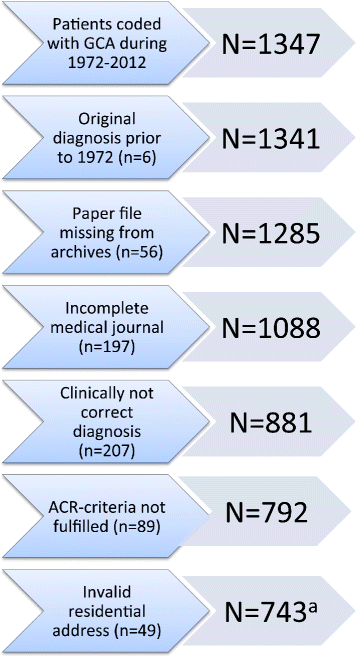Incidence of giant cell arteritis in Western Norway 1972-2012: a retrospective cohort study
- PMID: 29246164
- PMCID: PMC5732381
- DOI: 10.1186/s13075-017-1479-6
Incidence of giant cell arteritis in Western Norway 1972-2012: a retrospective cohort study
Erratum in
-
Correction to: Incidence of giant cell arteritis in Western Norway 1972-2012: a retrospective cohort study.Arthritis Res Ther. 2018 Dec 7;20(1):271. doi: 10.1186/s13075-018-1781-y. Arthritis Res Ther. 2018. PMID: 30526639 Free PMC article.
Abstract
Background: Giant cell arteritis (GCA) is the most common systemic vasculitis in persons older than 50 years. The highest incidence rates of the disease have been reported in Scandinavian countries. Our objective was to determine the epidemiology of GCA in an expected high-incidence region during a 41-year period.
Methods: This is a hospital-based, retrospective, cohort study. Patients diagnosed with GCA in Bergen health area during 1972-2012 were identified through computerized hospital records (n = 1341). Clinical information was extracted from patients' medical journals, which were reviewed by a standardized method. We excluded patients if data were unavailable (n = 253), if the reviewing rheumatologist found GCA to be an implausible diagnosis (n = 207) or if the American College of Rheumatology (ACR) 1990 classification criteria for GCA were not fulfilled (n = 89). Descriptive methods were used to characterize the sample. Incidence was analyzed by graphical methods and Poisson regression.
Results: A total of 792 patients were included. The average annual cumulative incidence of GCA was 16.7 (95% CI 15.5-18.0) per 100,000 of the population ≥ 50 years old. The corresponding incidence for biopsy-verified GCA was 11.2 (95% CI 10.2-12.3). The annual cumulative incidence increased with time in the period 1972-1992 (relative risk (RR) 1.1, p < 0.001) but not in 1993-2012 (RR 1.0, p = 0.543). The incidence was higher in women compared to men (average annual incidence 37.7 (95% CI 35.8-39.6) vs. 14.3 (95% CI 13.2-15.5), p < 0.001) with women having a twofold to threefold higher incidence rate throughout the study period. Average annual incidence increased with age until the 7th decade of life in both sexes throughout the study period (2.8 (95% CI 2.3-3.3) for age <60, 15.5 (95% CI 14.4-16.8) for age 60-69, 34.5 (95% CI 32.8-36.4) for age 70-79 and 26.8 (95% CI 25.3-28.4) for age ≥80 years, p < 0.001 for all age adjustments).
Conclusions: Our study confirms an incidence of GCA comparable to previous reports on Scandinavian populations. Our results show increasing incidence from 1972 through 1992, after which the incidence has levelled out.
Keywords: Epidemiology; Giant cell arteritis; Incidence; Norway; Temporal arteritis; Temporal artery biopsy; Vasculitis.
Conflict of interest statement
Ethics approval and consent to participate
The study was approved by the REK sør-øst B regional ethics committee (REC), which approved the study for all the hospitals involved (study reference number 2012/643/REK sør-øst B). The REC granted permission to access records without obtaining consent from patients or their relatives due to the long duration of the study and late onset of the disease. Most patients were elderly at time of diagnosis and many were deceased before the data collection began.
Consent for publication
Not applicable.
Competing interests
The authors declare that they have no competing interests.
Publisher’s note
Springer Nature remains neutral with regard to jurisdictional claims in published maps and institutional affiliations.
Figures



References
-
- Ninan J, Lester S, Hill C. Giant cell arteritis. Best practice & research. Clin Rheumatol. 2016;30(1):169–88. - PubMed
-
- Reinhold-Keller E, Zeidler A, Gutfleisch J, Peter HH, Raspe HH, Gross WL. Giant cell arteritis is more prevalent in urban than in rural populations: results of an epidemiological study of primary systemic vasculitides in Germany. Rheumatology (Oxford) 2000;39(12):1396–402. doi: 10.1093/rheumatology/39.12.1396. - DOI - PubMed
MeSH terms
LinkOut - more resources
Full Text Sources
Other Literature Sources
Medical

